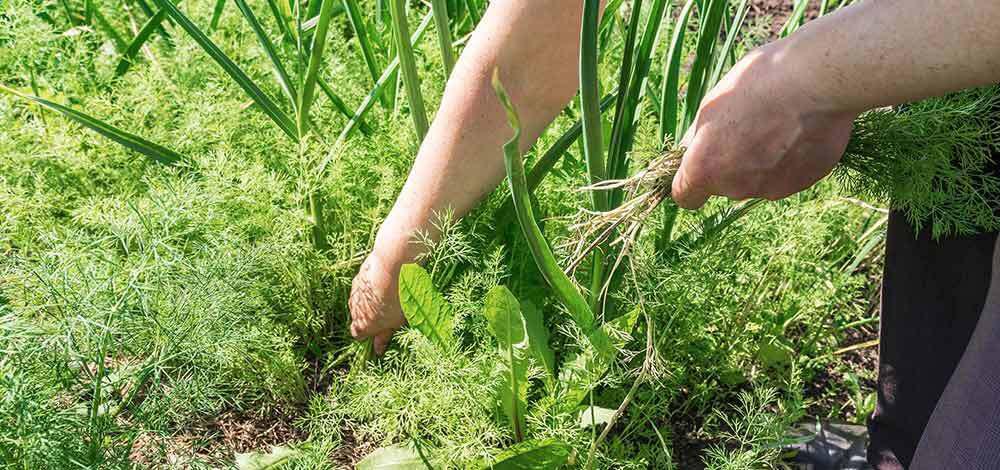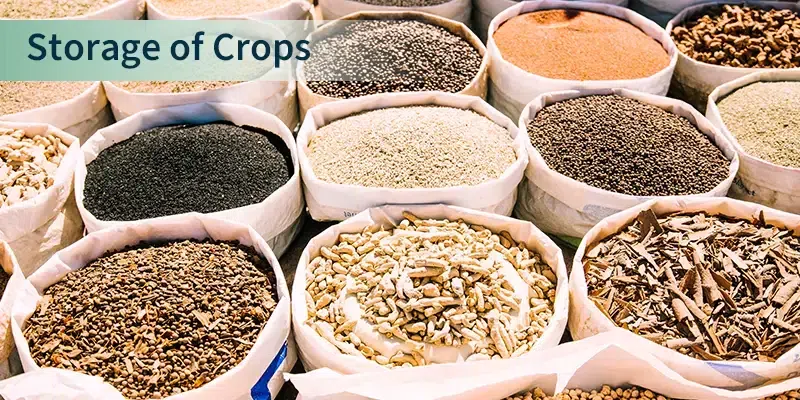Basic practice of crop production involves several key steps and considerations to ensure successful cultivation. Crops are plants that are grown on a large scale from the same variety. Agriculture is the practice of cultivating crops. The basic practice of crop production involves selecting suitable crops, preparing the soil, planting seeds, providing adequate water and nutrients, managing disease, monitoring crop growth, harvesting, and handling.
What is Crop Production?
Crop production involves the cultivation and growth of plants for human consumption. Crop production is a very common agricultural activity undertaken by farmers globally to cultivate crops for food and fibre. This process includes various practices essential for nurturing and yielding crops. Crops are of two types: Khariff and Rabi crops.

What are the Basic Practices of Crop Production?
The crops are grown in a very systematic manner. The following are examples of basic agricultural practices:
Soil Preparation
It is the first step before planting a crop and is one of the most important agricultural tasks. The turning and loosening of the soil allow the roots to penetrate deep into the soil and breathe freely even when they are deep in the soil.
The loosened soil also promotes the growth of earthworms and microbes, which turn and loosen the soil and add humus to it. As a result, it is critical to properly prepare the soil before beginning cultivation. The methods for soil preparation are listed below.
Ploughing or Tilling
- As only a few centimetres of the top layer of soil supports plant growth, turning and loosening the soil brings the nutrient-rich soil to the surface so that the plants can use it. It is accomplished by using a plough made of wood or iron. If the soil is extremely dry, it may need to be watered before ploughing.
Plough
- Ploughs are primarily used for tilling the soil, applying fertiliser to the crop, removing weeds and other waste materials from the field, and turning the soil. A plough is a wooden vehicle drawn by a pair of bulls or horses.
- It has a ploughshare, which is a strong and sharp triangular iron strip. The plough’s main component is a long log of wood known as the plough shaft. The other end is connected to a beam that is attached to the bull’s neck.
Hoe
- It is a simple tool for tilling the land, removing weeds, and digging up the soil. A long wooden rod is attached to one end by a bent iron plate. The other end could be connected to an animal.
Cultivator
- Tractors are used to power cultivators. Cultivators also kill weeds and remove unwanted vegetation from the field. Ploughing is now done with a tractor-driven cultivator.
Levelling
- The topsoil in the field is quite loose after it has been ploughed. The leveller, which is a heavy wooden or iron plank, is used to level the soil. Field levelling also aids in the uniform distribution of water during irrigation.
Base Manuring
- We add manure to the soil even before sowing to increase soil fertility because it is properly incorporated into the soil.
- The use of green manure and farmyard manure will always improve crop growth and yield.
Sowing
For sowing, high-quality, healthy seeds are collected. They must be planted at the appropriate depth in the soil. To aid in germination, they must be treated with chemicals. Weed control is performed to prevent weeds from entering the fertiliser. The soil should have enough water to allow for proper seed germination. Planting the seeds too close together reduces the amount of sunlight, water, and nutrients they receive. Sowing the seeds is done in a variety of ways.
Drilling Seeds
- A seed drill is a modern method of seeding. It is a more effective and efficient method than hand sowing. It is typically accomplished by attaching iron drills to a tractor.
- Seed drills ensure that seeds are planted in the soil at equal intervals and at the proper depth.
Dibbling
- It is the process of placing seed material at a predetermined spacing in a furrow, pit, or hole with a dibble, or more commonly by hand. For moist soil contact, the soil around the hole is pressed with the hand or leg.
Manual sowing
- Hand scattering of seeds is the most basic method of seed sowing. This is the most cost-effective method of seeding.
Adding Fertilizers and Manure
Manure and fertilisers are the materials that are put into the soil in the form of nutrients to promote plant growth. The ability of soil to naturally provide nutrients to agricultural plants in sufficient quantities and in the right proportions is referred to as fertility. These elements are crucial for the development of plants.
Fertilizer use is one of the methods used by farmers to increase yield. However, overuse can result in a capital loss in addition to crop loss. Most farmers, especially in developing countries, are unaware of the impact of fertilisers. Soil is the crop’s primary source of nutrients and minerals. Some soils, however, are mineral-poor or infertile. Even repeated farming can reduce soil fertility. In these cases, the soil must be replenished with nutrients from outside sources.
Fertilizers
- Fertilisers are chemical compounds that contain salts or organic compounds such as urea, ammonium sulphate, sodium nitrate, and others.
- They provide plant nutrients such as potassium, nitrogen, and phosphorus. Fertilisers are commercial products that are primarily produced in factories. They increased the yield on their own.
Manuring
- Manuring is the process of adding natural or chemical nutrient sources to a crop. Natural sources include plant, human, and animal wastes, excreta, and other wastes.
- These decompose into organic products known as organic manure or simply manure.
- Manure improves the soil’s water holding capacity, aeration, and texture. This resulted in the development of a new farming method known as organic farming, which uses only organic fertilisers, pesticides, and so on.
Crop Rotation
Crop rotation alternately grows different crops. Farmers in northern India used to grow legumes for fodder one season and wheat the next, which helped replenish the soil with nitrogen.
Farmers are being encouraged to return to this practice. Rhizobium bacteria are found in the nodules of leguminous plant roots and aid in the fixation of atmospheric nitrogen in the soil. This method can also be used to replenish the soil’s nutrients.
Irrigation
Irrigation can also be used to provide nutrients to crops. Water for irrigation can be obtained from wells, ponds, lakes, canals, tube wells, and even dams. Irrigation provides the necessary moisture for growth and development, germination, and other related functions.
The frequency, rate, amount, and time of irrigation differ for different crops, as well as depending on soil type and season. Summer crops, for example, require significantly more water than winter crops.
Modern Irrigation
The modern method compensates for the disadvantages of traditional methods and thus aids in the proper use of water.
The modern method of irrigation employs two systems:
- Sprinkler system
- Drip system
Also Read: Modern Methods of Irrigation
Traditional Irrigation
Irrigation is done manually in this method. A farmer pulls water from wells or canals by hand or with cattle and transports it to farming fields. This method may differ depending on where you live. Traditional systems include the pulley system, the lever system, and the chain pump. The pump system is the most common and widely used of these. However, its efficiency is low due to the uneven distribution of water. Furthermore, the likelihood of water loss is very high.
Also Read: Traditional Methods of Irrigation
Weeding
Many undesirable plants may naturally grow alongside the main crop in an agricultural field. Weeds are plants that are undesirable. Weeding is the process of removing weeds. Weeding is an important process because weeds compete for nutrients, sunlight, water, space, and other resources with crop plants. It causes crops to be undernourished, resulting in low yields. To achieve the expected yield, it is necessary to remove seeds from the field. Farmers use a variety of methods to remove weeds and control their growth.

Methods for removing weeds and controlling their growth
- Tilling prior to crop planting aids in the uprooting and killing of weeds, which then dry up and mix with the soil. The best time to remove weeds is before they flower and produce seeds.
- Weeds are also uprooted using a seed drill.
- Manual removal entails physically removing weeds by uprooting or cutting them close to the ground on a regular basis, using a khurpi.
Harvesting
- Harvesting is the process of cutting crops after they have reached maturity. Harvesting involves pulling or cutting crops close to the ground, which usually takes 3 to 4 years to mature.
- Harvesting is done either manually with a sickle or with a machine called a harvester.
- Winnowing is also used by farmers with small land holdings to separate grain and chaff. Harvest time is a time of great joy and happiness throughout India.
- Threshing is the process of separating grain seeds from chaff in a harvested crop. It is done with the help of a machine called a ‘combine,’ which is both a harvester and a thresher.

Storage
Because the crop is produced seasonally but consumed all year, storage is an important aspect of post-harvest technology. As a result, the supply of produce must be maintained through proper storage. Harvested grains should be dried thoroughly before storing them. Microorganisms will grow if there is any moisture in the stored grins. As a result, they must be sun-dried before storing. Grain is collected in gunny bags and stored in godowns. Silos and grains are large-scale grain storage structures.

To reduce pests and insects in godowns, chemical vapours are sprayed. This is known as fumigation. The stored grains are inspected on a regular basis to ensure that they are free of diseases and pests. Grain is stored on a large scale in government-owned godowns in our country. Food grains, oil seeds, seeds, and fodder are the various types of agricultural produce that require storage.
Conclusion – Basic Practices of Crop Production
Basic practice of crop production forms the foundation of successful agricultural ventures. From selecting appropriate crops, preparing soil, effective irrigation, fertilization, weed control and pest management, all crucial for ensuring for optimizing yields and ensuring sustainability. Continuous learning, adaptation to new technologies and commitment to sustainable practices are essential for farmers to meet the evolving challenges of modern agriculture while safeguarding the environment and securing food resources for future generation.
FAQs on Basic Practices of Crop Production
What is Crop Production?
Crop production is a common agricultural practice used by farmers all over the world to grow and produce crops for food and fiber.
What are Crumbs?
The ploughed field may contain large clumps of soil known as crumbs.
What are the Basic Operation in Crop Production?
The basic operation include land preparation, seed selection and planting, irrigation, fertilisation, weed control, pest and disease management, crop monitoring , harvesting, crop rotation.
What is Manual Harvesting?
Manual harvesting refers to the process of harvesting crop by hands without the use of tools.
What are the Most Effective Method for Controlling Weed?
The most effective methods are cultural practice, mechanical control, selective herbicides, preventive measures and biological control.
Like Article
Suggest improvement
Share your thoughts in the comments
Please Login to comment...